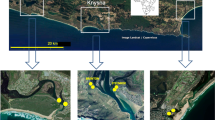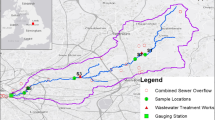Abstract
The extent of degradation of benthic communities of the Chesapeake Bay was determined by applying a previously developed benthic index of biotic integrity at three spatial scales. Allocation of sampling was probability-based allowing areal estimates of degradation with known confidence intervals. The three spatial scales were: (1) the tidal Chesapeake Bay; (2) the Elizabeth River watershed; and (3) two small tidal creeks within the Southern Branch of the Elizabeth River that are part of a sediment contaminant remediation effort. The areas covered varied from 10−1 to 104 km2 and all were sampled in 1999. The Chesapeake Bay was divided into ten strata, the Elizabeth River into five strata and each of the two tidal creeks was a single stratum. The determination of the number and size of strata was based upon consideration of both managerially useful units for restoration and limitations of funding. Within each stratum 25 random locations were sampled for benthic community condition. In 1999 the percent of the benthos with poor benthic community condition for the entire Chesapeake Bay was 47% and varied from 20% at the mouth of the Bay to 72% in the Potomac River. The estimated area of benthos with poor benthic community condition for the Elizabeth River was 64% and varied from 52–92%. Both small tidal creeks had estimates of 76% of poor benthic community condition. These kinds of estimates allow environmental managers to better direct restoration efforts and evaluate progress towards restoration. Patterns of benthic community condition at smaller spatial scales may not be correctly inferred from larger spatial scales. Comparisons of patterns in benthic community condition across spatial scales, and between combinations of strata, must be cautiously interpreted.
Similar content being viewed by others
References
Alden, R.W. III, Dauer, D.M., Ranasinghe, J.A., Scott, L.C. and Llansó, R.J.: 2002, ‘statistical verification of the Chesapeake Bay Benthic Index of Biotic Integrity’, Environmetrics. (In press).
Bricker, S.B., Clement, C.G., Pirhalla, D.E., Orlando, S.P. and Farrow, D.R.G.: 1999, ‘National estuarine eutrophication assessment: effects of nutrient enrichment in the nation's estuaries’, NOAA, National Ocean Service, Special Projects Office and the National Centers for Coastal Science. Silver Spring, Maryland, 71 pp.
CBP (Chesapeake Bay Program): 1999. ‘Targeting toxics: A characterization report. A tool for directing management and monitoring actions in the Chesapeake Bay's tidal rivers’, Chesapeake Bay Program, U.S. Environmental Protection Agency, Annapolis, Maryland, 49 pp.
Dauer, D.M.: 1993, ‘Biological criteria, environmental health and estuarine macrobenthic community structure’, Marine Pollution Bulletin 26, 249–257.
Dauer, D.M.: 1997, ‘Dynamics of an estuarine ecosystem: Long-term trends in the macrobenthic communities of the Chesapeake Bay, USA (1985–1993)’, Oceanologica Acta 20, 291–298.
Dauer, D.M.: 2000, ‘Benthic Biological Monitoring Program of the Elizabeth River Watershed (1999)’, Final Report to the Virginia Department of Environmental Quality, Chesapeake Bay Program, 73 pp.
Dauer, D.M. and Alden III, R.W.: 1995, ‘Long-term trends in the macrobenthos and water quality of the lower Chesapeake Bay (1985–1991)’, Marine Pollution Bulletin 30, 840–850.
Dauer, D.M., Lane, M.F., Marshall, H.G., Carpenter, K.E. and Diaz, R.J.: 1999, ‘status and trends in water quality and living resources in the Virginia Chesapeake Bay: 1985–1998’, Final report to the Virginia Department of Environmental Quality. 65 pp.
Dauer, D.M., Luckenbach, M.W. and Rodi, Jr., A.J.: 1993, ‘Abundance biomass comparison (ABC method): effects of an estuarine gradient, anoxic/hypoxic events and contaminated sediments’, Marine Biology 116, 507–518.
Dauer, D.M., Ranasinghe, J.A. and Rodi, Jr., A.J.: 1992, ‘Effects of low dissolved oxygen levels on the macrobenthos of the lower Chesapeake Bay’, Estuaries 15, 384–391.
Dauer, D.M., Ranasinghe, J.A. and Weisberg, S.B.: 2000, ‘Relationships between benthic community condition, water quality, sediment quality, nutrient loads, and land use patterns in Chesapeake Bay’, Estuaries 23, 80–96.
Diaz, R.J. and Rosenberg, R.:1995. ‘Marine benthic hypoxia: a review of its ecological effects and the behavioural responses of benthic macrofauna’, Oceanography and Marine Biology: An Annual Review 33 , 245–305.
Elizabeth River Project: 2000, ‘state of the River 2000,’ Elizabeth River Project, Norfolk, Virginia, 24 pp.
Kennish, M.J.: 1998, Pollution impacts on marine biotic communities, CRC Press, Boca Raton, 310 pp.
Kingsford, M.J.: 1998, ‘Analytical aspects of sampling design’, in Kingsford, M. and Battershill, C. (eds), Studying temperate marine environments. A handbook for ecologists, CRC Press, Boca Raton, p. 49–83.
Kingsford, M.J. and Battershill, C. N.: 1998, ‘Procedures for establishing a study’, in Kingsford, M. and Battershill, C. (eds), Studying temperate marine environments. A handbook for ecologists, CRC Press, Boca Raton, p. 29–48.
Kramer, K.J.M.: 1994, Biomonitoring of coastal waters and estuaries, CRC Press, Boca Raton, 327 pp.
Livingston, R.J.: 2001, Eutrophication processes in coastal systems, CRC Press, Boca Raton, 327 pp.
Llansó, R.J., Dauer, D.M., Vølstad, J. H., and Scott, L.C.: 2001, ‘Application of the Benthic Index of Biotic Integrity to environmental monitoring in Chesapeake Bay’, Environmental Monitoring and Assessment THIS ISSUE.
Ranasinghe, J.A., Weisberg, S.B., Dauer, D.M., Schaffner, L.C., Diaz, R.J. and Frithsen, J.B.: 1994, ‘Chesapeake Bay benthic community restoration goals’, Report for the U.S. Environmental Protection Agency, Chesapeake Bay Office and the Maryland Department of Natural Resources. 49 pp.
Schenker, N. and Gentleman, J.F.: 2001, ‘On judging the significance of differences by examining the overlap between confidence intervals’, The American Statistician 55, 182–186.
Smith, D.E, Leffler, M. and Mackiernan, G.: 1992, ‘Oxygen dynamics in the Chesapeake Bay. A synthesis of recent research’, Maryland Sea Grant College, College Park, Maryland, 234 pp.
USACOE (U.S. Army Corps of Engineers): 2001, Draft Feasibility Study and Draft Environmental Assessment, Main Report, Elizabeth River Basin, Environmental Restoration, U.S. Army Corps of Engineers, Norfolk District, Norfolk, Virginia, 188 pp.
USEPA (U.S. Environmental Protection Agency): 1999, The State of the Chesapeake Bay, EPA/903–R99–013, CBP/TRS222/108, U.S. Environmental Protection Agency, Annapolis, Maryland, 58 pp.
Weisberg, S.B., Ranasinghe, J.A., Dauer, D.M., Schaffner, L.C., Diaz. R.J. and Frithsen, J.B.: 1997, ‘An estuarine benthic index of biotic integrity (B-IBI) for Chesapeake Bay’, Estuaries 20, 149–158.
Author information
Authors and Affiliations
Rights and permissions
About this article
Cite this article
Dauer, D.M., Llansó, R.J. Spatial Scales and Probability Based Sampling in Determining Levels of Benthic Community Degradation in the Chesapeake Bay. Environ Monit Assess 81, 175–186 (2003). https://doi.org/10.1023/A:1021329108568
Issue Date:
DOI: https://doi.org/10.1023/A:1021329108568




